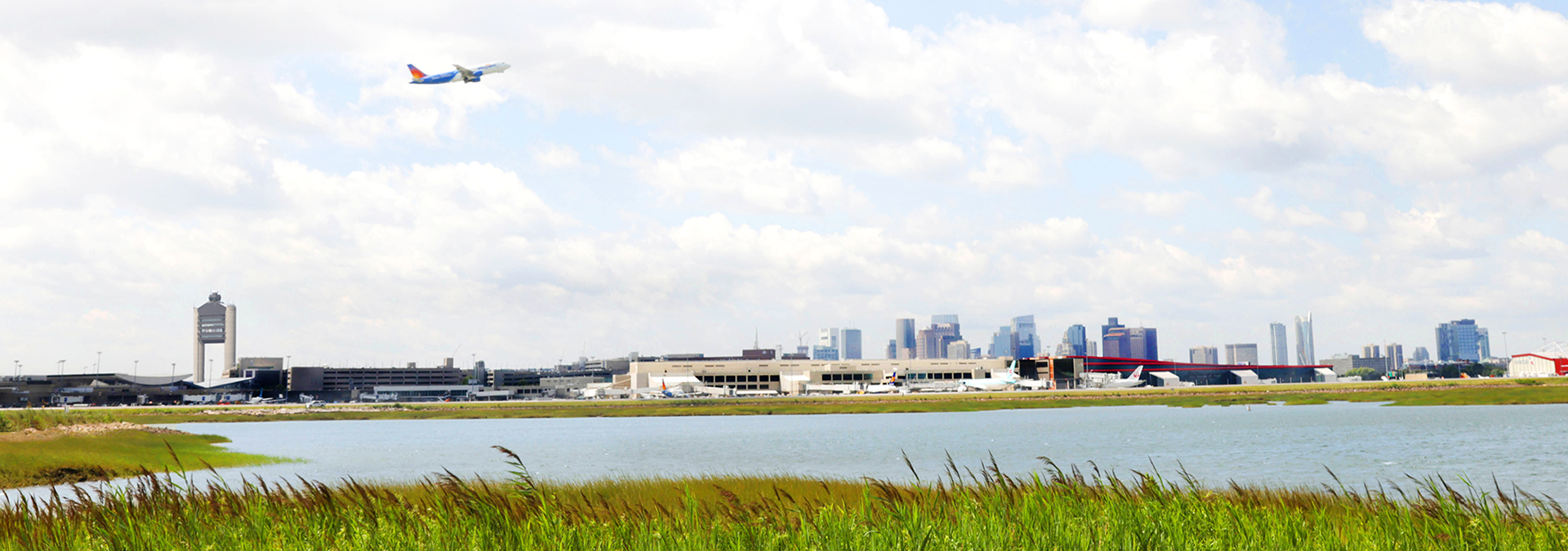
Sustainability
Water Quality
Learn more about Massport’s comprehensive water quality management program.
Boston Logan International Airport
Boston Logan is bordered by Boston Harbor. This proximity to the harbor necessitates careful planning and management of airport operations to ensure that airfield activities do not adversely affect harbor water quality and associated sensitive natural resources. Massport has a comprehensive water quality management program in place to protect water quality at Boston Logan. This includes protection of surface water as well as groundwater, and coastal resources from airport operations and during construction.
Massport’s primary water quality goal is to prevent pollutant discharges, thus limiting potential adverse impacts associated with airport activities. Massport implements best management practices (BMPs) for pollution prevention for activities that may impact surface and groundwater quality, and provides guidance to tenants on how to implement responsible environmental practices and BMPs.
Stormwater Management
Protection of surface water and groundwater resources is a high priority at Boston Logan. A major component of Massport’s water pollution prevention program is the development and implementation of a comprehensive stormwater pollution prevention plan (SWPPP). The SWPPP integrates both water quality treatment and monitoring programs.
The federal Clean Water Act requires permits for pollutant discharges into United States waters from a point source and for stormwater discharges associated with industrial activities. Permits are issued under the federal Environmental Protection Agency’s (EPA) National Pollutant Discharge Elimination System (NPDES) Program.
Presently, Massport holds two NPDES permits for Boston Logan: one permit for stormwater discharges from the four major outfalls at the airport as well as a number of smaller airfield outfalls, and another permit for treated water discharges from firefighting training operations at the fire training facility in the southeast portion of the airfield. To ensure permit compliance, Massport monitors discharges from Boston Logan and submits regular data reports to the U.S. EPA and the Massachusetts Department of Environmental Protection (DEP).
Additional historical monitoring results can be found in the Boston Logan Environmental Data Reports and Environmental Status and Planning Reports.
Monitoring Results
Water quality samples are collected regularly from Boston Logan airport outfalls. The main outfalls that serve the terminal and operational areas are tested twice each month. One round of monitoring is conducted during dry weather and another during wet weather. These samples are tested for oil and grease, solids, hydrocarbons, bacteria, and surfactants. Quarterly sampling is conducted at the airfield outfalls for oil and grease, solids, and hydrocarbons. Monitoring for deicers is conducted twice each winter during a snow or ice event.
| 2025 | |||
|---|---|---|---|
| January | February | March | April |
| May | June | July | August |
| September | October | November | December |
| Quarter 1 | Quarter 2 | Quarter 3 | Quarter 4 |
| 2024 | |||
|---|---|---|---|
| January | February | March | April |
| May | June | July | August |
| September | October | November | December |
| Quarter 1 | Quarter 2 | Quarter 3 | Quarter 4 |
| 2023 | |||
|---|---|---|---|
| January | February | March | April |
| May | June | July | August |
| September | October | November | December |
| Quarter 1 | Quarter 2 | Quarter 3 | Quarter 4 |
| 2022 | |||
|---|---|---|---|
| January | February | March | April |
| May | June | July | August |
| September | October | November | December |
| Quarter 1 | Quarter 2 | Quarter 3 | Quarter 4 |
| 2021 | |||
|---|---|---|---|
| January | February | March | April |
| May | June | July | August |
| September | October | November | December |
| Quarter 1 | Quarter 2 | Quarter 3 | Quarter 4 |
| 2020 | |||
|---|---|---|---|
| January | February | March | April |
| May | June | July | August |
| September | October | November | December |
| Quarter 1 | Quarter 2 | Quarter 3 | Quarter 4 |
Spill Management
The accidental release of fuel to the environment has a potential to adversely impact surface water and groundwater features and associated environmental resources. This is particularly important since Boston Logan is bordered by Boston Harbor. Massport takes a proactive approach to spill control and management in an effort to avoid spills and minimize impact in the event there is a spill.
One important element of this comprehensive program involves Massport closely monitoring fuel spillage by tenants and tracking the status of spill response actions. Massport ensures that each spill is cleaned up appropriately, with all required documentation, in compliance with Massachusetts DEP regulations.